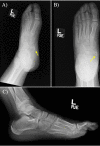Symptomatic Patient With Two Separate Accessory Navicular Bones
- PMID: 38022136
- PMCID: PMC10681632
- DOI: 10.7759/cureus.47881
Symptomatic Patient With Two Separate Accessory Navicular Bones
Abstract
We present the case of a symptomatic patient with two separate accessory navicular bones, a novel finding that does not fall within current classification standards. Furthermore, there is a paucity of current literature with regard to the management of symptomatic cases. Accessory navicular bones, sometimes referred to as os naviculare, are ossicles that can occur in multiple configurations and are considered developmental anomalies. The accessory navicular is an accessory bone found on the medial side of the navicular bone of the foot. While often asymptomatic, they can occasionally lead to clinically significant pain and/or deformity that can cause patients to seek out treatment and sometimes surgical correction. Diagnosis relies on clinical suspicion and imaging studies. A nine-year-old female patient presented initially with complaints of sharp pain over the medial side of her left foot, after which X-rays were obtained that demonstrated an accessory navicular bone. Upon diagnosis, conservative measures were implemented, including placing the patient in a short-leg cast with limited activity. After a failed trial of conservative measures, the patient underwent surgical excision of the accessory navicular bone, with imaging and intraoperative findings of two separate accessory navicular bones, a unique finding in patients with accessory navicular bones. During the six-week follow-up, the patient improved with no new complaints or concerns and was informed she could begin weight-bearing as tolerated with two crutches; she was then weaned from the crutches and returned to normal activity. In the current case, we followed the same route of treatment used to treat a single accessory navicular bone, utilizing first non-surgical interventions and then ultimately surgical excision after continual pain despite conservative measures. This case highlights the promising outcome for a patient with two separate accessory navicular bones when following the guidelines for the treatment of a single accessory navicular bone.
Keywords: accessory navicular bone; bipartite os naviculare; geist classification; os naviculare treatment; surgical excision.
Copyright © 2023, Sharkey et al.
Conflict of interest statement
The authors have declared that no competing interests exist.
Figures



References
-
- Sarrafian SK. Philadelphia, PA: Lippincott Williams & Wilkins; 1993. Sarrafian's Anatomy of the Foot and Ankle: Descriptive, Topographic, Functional.
-
- The painful accessory navicular. Lawson JP, Ogden JA, Sella E, Barwick KW. Skeletal Radiol. 1984;12:250–262. - PubMed
-
- Percutaneous drilling of symptomatic accessory navicular in young athletes. Nakayama S, Sugimoto K, Takakura Y, Tanaka Y, Kasanami R. Am J Sports Med. 2005;33:531–535. - PubMed
-
- International Skeletal Society Lecture in honor of Howard D. Dorfman. Clinically significant radiologic anatomic variants of the skeleton. Lawson JP. AJR Am J Roentgenol. 1994;163:249–255. - PubMed
-
- Philadelphia, PA: Elsevier Saunders; 2014. Mann’s Surgery of the Foot and Ankle.
Publication types
LinkOut - more resources
Full Text Sources
Miscellaneous
